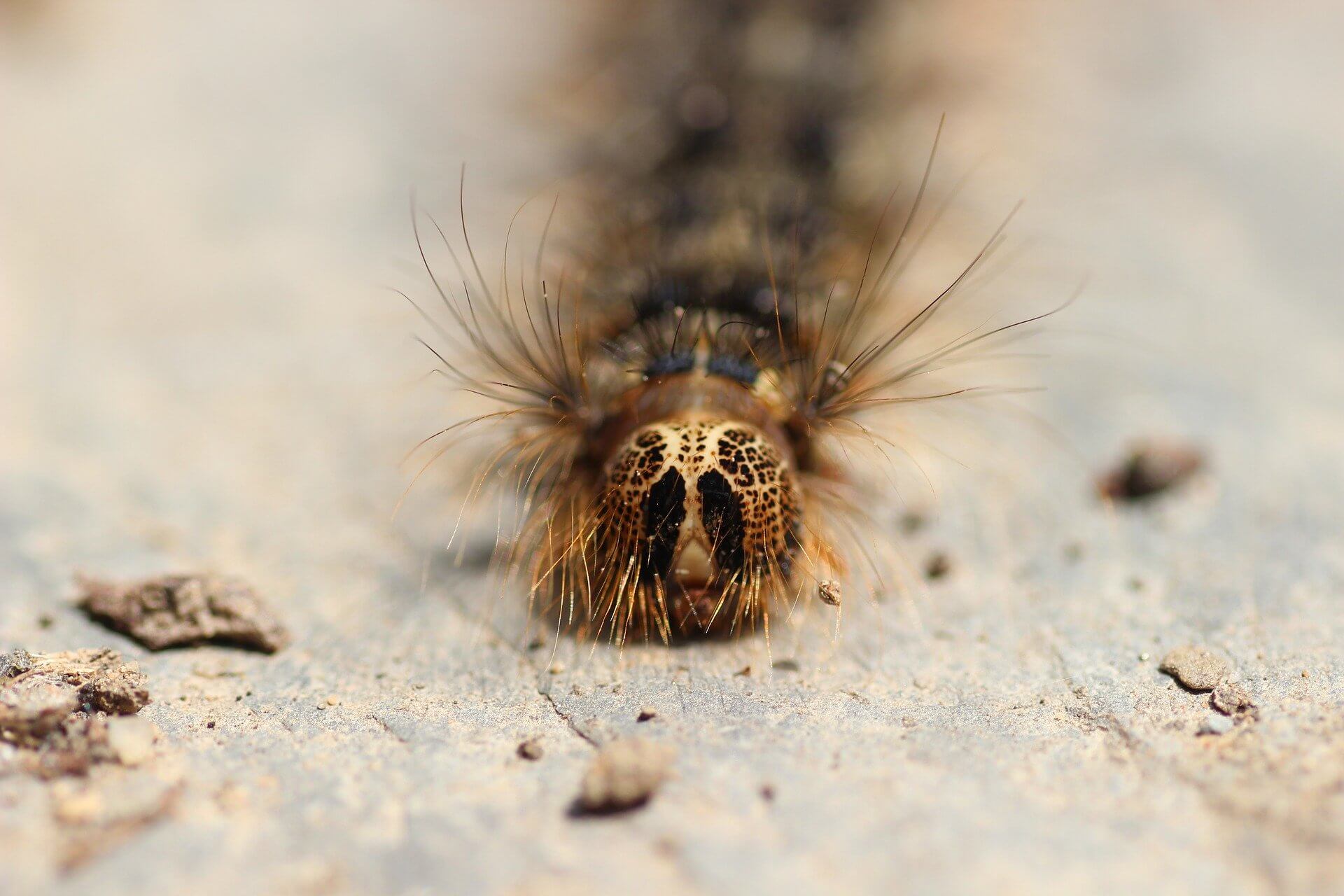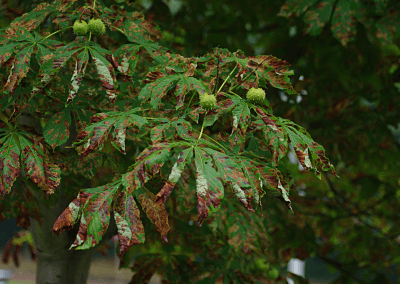What are Gypsy Moths?
Gypsy moths are one of the most invasive species the world over. They are a pest whose sole purpose is to consume the leaves of trees and shrubs. While there are over 500 species of flora that gypsy moths consume, they particularly like hardwood trees, such as cottonwood, elm, and birch. A gypsy moth infestation is not something you want.
It’s important to identify gypsy moths in the caterpillar stage as other types of caterpillars are not as detrimental to your garden. Gypsy moth caterpillars are about 2 inches in length and are very hairy. They are distinguished by five pairs of blue dots and then six pairs of red dots.
While gypsy moths don’t live very long as actual moths, you can identify them by their hairy bodies. Male gypsy moths are grey while female gypsy moths are white. Interestingly, though, female gypsy moths can’t actually fly.
Life Cycle of a Gypsy Moth
Like all moths, gypsy moths have a standard life cycle. They begin as eggs which are laid on branches of trees and shrubs. However, these eggs can also be found in sheltered areas such as beside rocks. When the eggs are laid, a covering of hairs protects the eggs, insulating them from the cold and protecting them from predators.
After a month, the eggs essentially hibernate over winter. Gypsy moth larvae aren’t born until 8 or 9 months later. Once spring arrives, gypsy moth caterpillars, or larvae, are born. This is when the most amount of damage occurs.
Once they emerge from their eggs, gypsy moth caterpillars eat the protective hair around them and then the leaves in their vicinity. They don’t really stop eating until they reach the next stage in life, the pupal stage, which occurs from June to July.
Finally, gypsy moths emerge from their cocoons in July and August. Once they are fully-formed moths, they only live about one week, just enough time to lay eggs and start their life cycle all over again.
Signs of Gypsy Moth Infestation
The good news with gypsy moth damage is that your tree can recover. The bad news is that it can take a real toll on its health.
Start by looking at the leaves of your trees. If you have giant holes in your leaves, or your healthy leaves have seemingly disappeared overnight, this is a sign of a gypsy moth infestation.
Another key sign to look for is masses of gypsy moth eggs. This can look almost like a giant spider’s web, thanks to the fibrous hairs that cover the eggs in a protective layer. Each egg mass can have about 300 eggs, so it should be fairly obvious.
Solutions to Gypsy Moth Damage
The best solutions to gypsy moth infestation is to targe their different life cycles.
Egg Stage: September to April
One benefit pest control agencies have against gypsy moths is that the insect has a very large egg intubation period. After laying their eggs in September, gypsy moth eggs lay dormant for much of the year.
Furthermore, the eggs of gypsy moths are usually in clusters. You can destroy a large amount of eggs in just one location.
In the fall, perform a through inspection of your yard. Remember to look both up and down for gypsy moth eggs. They can be high in the treetops and low in the rocky ground. Look for large masses of fibres or hair, to spot their egg masses.
If you have seen an egg mass, collect the whole substance and place it in mild soapy water. Leave the egg mass in the water solution for a few days so that it can fully penetrate the egg sacs. You will want to wear gloves when handling the egg mass as the hair fibres can be a bit sticky.
Another method of destroying the gypsy moth eggs is to take a dull knife and scrape off the eggs from a branch. Once they hit the ground, be sure to crush the eggs fully so that there are no accidental survivors.
Finally, if you have a leaf blower/vacuum you can suction up the eggs. Just be sure to empty the vacuum to destroy the contents.
Larva Stage: April to May
Despite your best intentions, you may have missed some egg masses in your yard. The next step is all about preventing the gypsy moth larva from finding their way to an open food source.
Prevent the gypsy moth caterpillars from moving up tree trunks by taping duct tape around the base. Then, apply a sticky substance to the tape. This will prevent the caterpillars from crawling up the tree, thus removing the higher leaves as a food source.
Late Caterpillar Stage: June to August
As the larva grow in size and become full-fledged caterpillars, their eating patterns change. They become nocturnal and will eat at night.
You can start to trap the caterpillars by using burlap sacs. Take a piece of burlap that is about 3 feet in width. Wrap it around the tree trunk and then place a rope around the middle of the burlap. The top will fold over, leaving a very convenient place for caterpillars to hide during the day.
Once it becomes late afternoon, perform a quick inspection of your burlap. If there are gypsy moth caterpillars hiding, you can trap and kill them before they are able to climb higher and reach the tree leaves. Always use gloves when handling gypsy moth caterpillars as they can lead to skin irritation.
Will my Trees Recover?
Thankfully, if you are able to remove a gypsy moth infestation from your yard, your trees will recover. You may even find that once the caterpillars are removed in the summer, your trees will naturally restart growing their leaves right away.
However, if a gypsy moth infestation is allowed to continue for multiple years, your trees will become quite weak and will therefore be prone to damage. Tree removal might even be a necessity.
Prevention and education are the two tools that will keep your yard healthy and stop the spread of gypsy moths. If you’re still not sure how to deal with a gypsy moth infestation, be sure to contact us and an expert can help you.


